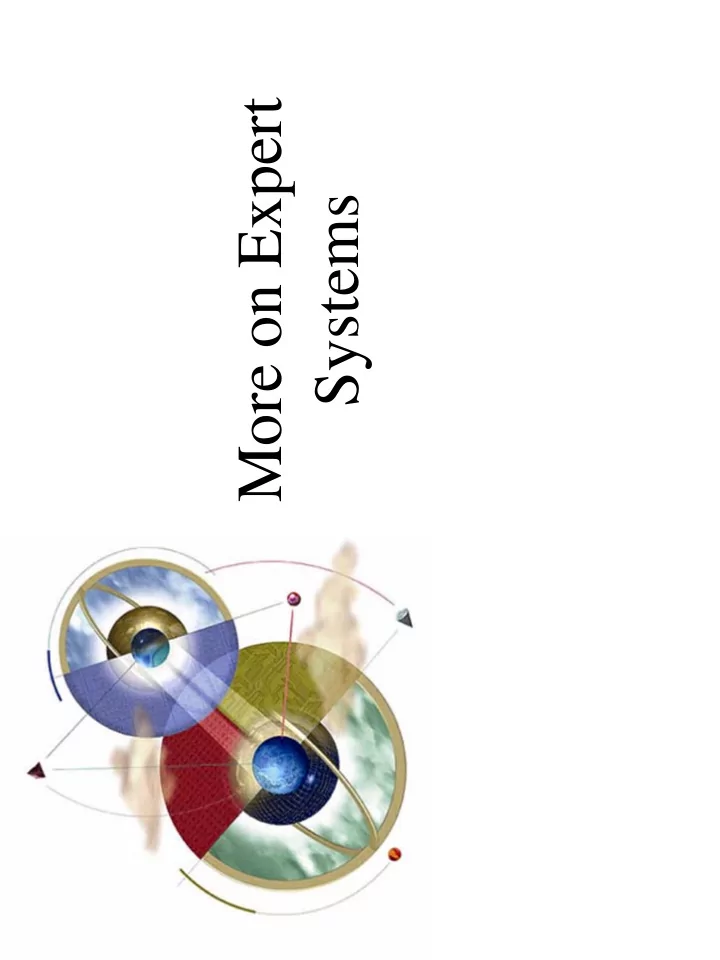

More on Expert Systems
Knowledge Engineering The process of building an expert system: 1. The knowledge engineer establishes a dialog with the human expert to elicit knowledge. 2. The knowledge engineer codes the knowledge explicitly in the knowledge base. 3. The expert evaluates the expert system and gives a critique to the knowledge engineer. 2
Development of an Expert System 3
Uncertainty • Uncertainty = having limited knowledge (more than possible outcomes) • Both human experts and expert systems must be able to deal with uncertainty. • It is easier to program expert systems with shallow knowledge than with deep knowledge. • Shallow knowledge – based on empirical and heuristic knowledge. • Deep knowledge – based on basic structure, function, and behavior of objects. 4
Limitations of Expert Systems • Limitation 1: typical expert systems cannot generalize through analogy to reason about new situations in the way people can. • Solution 1 for limitation 1: repeating the cycle of interviewing the expert. • Limitation raised form Solution 1: A knowledge acquisition bottleneck results from the time- consuming and labor intensive task of building an expert system. 5
Early Expert Systems • DENDRAL – used in chemical mass spectroscopy to identify chemical constituents • MYCIN – medical diagnosis of illness • DIPMETER – geological data analysis for oil • PROSPECTOR – geological data analysis for minerals • XCON/R1 – configuring computer systems 6
Broad Classes of Expert Systems 7
Problems with Algorithmic Solutions • Conventional computer programs generally solve problems having algorithmic solutions. • Algorithmic languages include C, Java, and C#. • Classic AI languages include LISP and PROLOG. 8
Considerations for Building Expert Systems • Can the problem be solved effectively by conventional programming? • Is there a need and a desire for an expert system? • Is there at least one human expert who is willing to cooperate? • Can the expert explain the knowledge to the knowledge engineer in a way that can understand it. • Is the problem-solving knowledge mainly heuristic and uncertain? 9
Languages, Shells, and Tools • Expert system languages are post-third generation. • Expert system languages (e.g. CLIPS) focus on ways to represent knowledge. • Tool = language + utility program (code generator, graphics editor, debuggers, etc.). • Shell: is a special purpose tool designed for certain types of applications in which the user must supply the knowledge base. Example, EMYCIN (empty MYCIN) 10
Elements of an Expert System • User interface – mechanism by which user and system communicate. • Exploration facility – explains reasoning of expert system to user. • Working memory – global database of facts used by rules. • Inference engine – makes inferences deciding which rules are satisfied and prioritizing. 11
Elements Continued • Agenda – a prioritized list of rules created by the inference engine, whose patterns are satisfied by facts or objects in working memory. • Knowledge acquisition facility – automatic way for the user to enter knowledge in the system bypassing the explicit coding by knowledge engineer. 12
Structure of a Rule-Based Expert System 13
Production Rules • Knowledge base is also called production memory. • Production rules can be expressed in IF-THEN pseudocode format. • In rule-based systems, the inference engine determines which rule antecedents are satisfied by the facts. 14
Inference engine operates on recognize-act cycle While not done conflict resolution: act: match: check for halt: End-while 15
Inference engine operates on recognize-act cycle - conflict resolution: if there are activations then select the one with the highest priority. Else done. - act: sequentially perform the actions. Update the working memory. Remove the fired activations. - match: Update the agenda by checking if there are activation or remove activations if there LHS is no longer satisfied. - check for halt: if an halt action is performed or break command given, then done. 16
General Methods of Inferencing • Forward chaining – reasoning from facts to the conclusions resulting from those facts – best for prognosis, monitoring, and control. • Backward chaining – reasoning in reverse from a hypothesis, a potential conclusion to be proved to the facts that support the hypothesis – best for diagnosis problems. 17
Production Systems • Rule-based expert systems – most popular type today. • Knowledge is represented as multiple rules that specify what should/not be concluded from different situations. • Forward chaining – start w/facts and use rules do draw conclusions/take actions. • Backward chaining – start w/hypothesis and look for rules that allow hypothesis to be proven true. 18
Post Production System • Basic idea – any mathematical / logical system is simply a set of rules specifying how to change one string of symbols into another string of symbols. • Basic limitation – lack of control mechanism to guide the application of the rules. 19
What are Expert Systems? Can be considered declarative languages: • Programmer does not specify how to achieve a goal at the algorithm level. • Induction-based programming – the program learns by generalizing from a sample. 20
Recommend
More recommend